Holly Riding: Redefining Exhibition Design Through Art, Technology and Inclusivity

Introduction
In the dynamic world of exhibition design and cultural curation, few names stand out as distinctly as Holly Riding. A leading Australian exhibition designer and curator, Riding has carved a niche at the intersection of art, technology, and accessibility. Her practice merges creativity with purpose, reshaping how audiences interact with culture and storytelling in public spaces.
From the State Library of Queensland to the WAMA Foundation, her work consistently demonstrates how art can be both visually striking and socially meaningful. This article explores the journey, philosophy, and contributions of Holly Riding, whose innovative approach is setting new benchmarks in exhibition design across Australia.
The Creative Vision of Holly Riding
Art Beyond Aesthetics
For Holly Riding, art has never been confined to the gallery wall. Her design philosophy goes beyond aesthetics to address the deeper purpose of exhibitions — to engage, educate, and inspire communities. She believes that exhibition spaces should be alive with interaction, offering visitors not just something to see, but something to feel and experience.
Riding’s practice integrates public art and digital technology to build experiences that resonate with diverse audiences. By combining visual storytelling with immersive spatial design, she transforms cultural venues into participatory environments that invite visitors to explore, question, and connect.
Purpose-Led Design
Central to Riding’s methodology is her commitment to purpose-led design. She approaches each exhibition as an opportunity to promote inclusion, accessibility, and environmental awareness. Her goal is not merely to display art but to use design as a tool for social change — ensuring that every person, regardless of background or ability, can access and appreciate the cultural stories on display.
This thoughtful approach positions her work within a global movement toward inclusive design in the arts. Her exhibitions are crafted with accessibility in mind, from spatial planning and sensory experiences to digital interactivity, making the cultural sector more open and equitable.
Career Path and Professional Background
Foundations in Exhibition Design
Based in East Brisbane, Queensland, Holly Riding has developed her career within Australia’s vibrant cultural landscape. Her expertise lies in the full spectrum of exhibition design — from conceptual development and spatial planning to production management and delivery.
Riding’s professional journey includes significant roles in exhibition management, working closely with institutions to translate curatorial visions into compelling physical and digital realities. Her work has become synonymous with precision, creativity, and a deep respect for artistic intent.
Collaboration with Major Institutions
Over the years, Riding has collaborated with several high-profile cultural organisations, most notably the State Library of Queensland and the WAMA Foundation. Her contributions to these institutions reflect her ability to balance artistic innovation with logistical and curatorial demands.
Among her most notable projects are:
The “NEON” Exhibition (2024) – A vibrant and visually striking installation at the State Library of Queensland that explored light, identity, and technology through contemporary design.
The National Photographic Portrait Prize (2024) – A celebrated exhibition where Riding’s design elevated the presentation of Australia’s most compelling photographic works.
WAMA Foundation Opening Exhibitions (2025) – A major environmental art initiative in Halls Gap that showcases her commitment to sustainability and the natural world.
These projects not only highlight her artistic range but also her ability to weave together storytelling, architecture, and audience engagement in a seamless experience.
Innovation Through Technology
Digital Storytelling and Spatial Intelligence
One of the hallmarks of Holly Riding’s design practice is her use of digital technology as a medium for storytelling. She recognises that in today’s digital era, audiences crave interaction and personal connection. Through innovative use of projection mapping, interactive screens, and sensory installations, she transforms exhibition environments into living, breathing narratives.
Her understanding of spatial intelligence allows her to create pathways that guide visitors naturally through a story. Each display is carefully positioned to encourage curiosity and discovery, ensuring that the journey through the exhibition feels organic and emotionally engaging.
The Fusion of Art and Accessibility
Technology in Riding’s work is not used for spectacle alone — it serves a greater purpose of accessibility. Her projects often include elements that accommodate a variety of needs, from digital guides for the visually impaired to immersive soundscapes for those who experience art differently.
This emphasis on inclusive design demonstrates her belief that art belongs to everyone. By merging digital tools with empathetic design principles, Holly Riding ensures that no visitor is excluded from the cultural conversation.
Design Philosophy and Impact
Human-Centred Curatorship
At the core of Holly Riding’s approach lies a human-centred philosophy. She sees exhibition design as a form of storytelling where each element — light, space, texture, and sound — plays a part in communicating an idea. Her ability to balance artistic vision with audience psychology has made her one of the most respected exhibition designers in Australia.
Her exhibitions are not static displays but evolving environments that encourage reflection and dialogue. In this way, Riding redefines what it means to curate — she does not merely arrange objects, but orchestrates experiences that speak directly to the human spirit.
Sustainability and Cultural Responsibility
Beyond aesthetics and accessibility, Holly Riding also advocates for sustainability within the arts. Her collaboration with the WAMA Foundation — an institution dedicated to environmental art — underscores her belief that exhibition design can promote ecological awareness.
Through the use of sustainable materials and low-impact production methods, she demonstrates how creativity and responsibility can coexist. Her designs embody the idea that the spaces we create should reflect our respect for both people and the planet.
The Future of Exhibition Design
Redefining Cultural Spaces
As museums and galleries evolve to meet the expectations of modern audiences, professionals like Holly Riding are leading the way forward. Her fusion of design, technology, and inclusivity offers a blueprint for the future of cultural spaces — places that are interactive, accessible, and deeply connected to their communities.
By embracing digital tools and human-centred design, she challenges traditional notions of what an exhibition can be. Her work invites the cultural sector to think beyond walls, encouraging institutions to see exhibitions as experiences that live within people’s memories long after they leave the gallery.
Inspiring the Next Generation
Holly Riding’s influence extends beyond her immediate projects. She serves as an inspiration for emerging designers and curators who seek to merge artistry with purpose. Her dedication to inclusive and sustainable design provides a model for future practitioners eager to create meaningful change through cultural storytelling.
Her story proves that innovation does not always come from technology alone — it comes from empathy, awareness, and a deep commitment to human experience.
Conclusion
Holly Riding stands at the forefront of a new era in exhibition design. Her visionary blend of creativity, inclusivity, and technology is transforming the way we experience art and culture. Through her thoughtful and purpose-driven practice, she continues to shape spaces that not only display art but also inspire connection, reflection, and dialogue.
In an industry often defined by tradition, Riding’s work is a reminder that the future of culture lies in innovation, empathy, and accessibility. Her influence continues to expand, ensuring that Australia remains a leader in progressive exhibition design for years to come.



